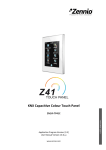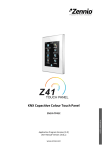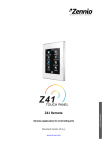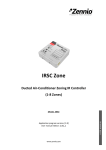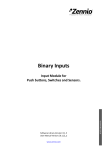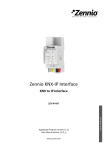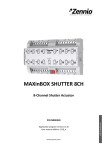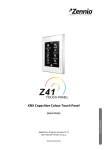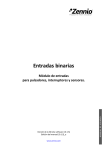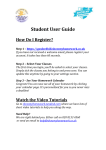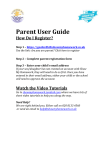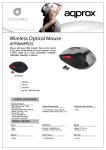Download InZennio Z41
Transcript
Z41 Remote USER MANUAL Remote Application for Controlling Z41 Document Version: b www.zennio.com InZennio Z41 Contents Introduction.............................................................................................................................. 3 iOS Application (iPhone) ............................................................................................... 4 Installation ............................................................................................................. 4 Device Pairing ........................................................................................................ 7 Controlling the Device ............................................................................................ 9 User Profiles......................................................................................................... 11 http://www.zennio.com Tecnical Support: http://zennioenglish.zendesk.com 2 InZennio Z41 INTRODUCTION Versions 3.0 and later of the Z41 application program feature a specific function for the remote control of the device, which lets the user acting over the screen by means of remote mobile devices in the same manner as during on-site interaction. This document is offered as a guide for integrators who are willing to configure Z41 for being used from these remote applications. Hence, reading this document together with the actual Z41 user manual is encouraged. http://www.zennio.com Tecnical Support: http://zennioenglish.zendesk.com 3 InZennio Z41 iOS APPLICATION (iPhone) Z41 can be controlled from remote devices running the iOS operating system. This is possible by installing the Z41 Remote specific application, developed by Zennio and available at the App Store. INSTALLATION The Z41 Remote application should be downloaded from the App Store: Figure 1 Z41 Remote app on the App Store Once installed on the terminal, it can be launched by pressing on its icon, similar to the logotype shown in Figure 1. When Z41 Remote runs for the first time, the user will be shown the terms and conditions of use: http://www.zennio.com Tecnical Support: http://zennioenglish.zendesk.com 4 InZennio Z41 Figure 2 Terms and conditions of use After agreeing with the thems, the main window of the application will be show up, as in Figure 3. Figure 3 Main window Four main elements can be identified: Device list: list of the devices already linked to the application through the pairing procedure. This list shows no elements on the first execution. Add device: button that brings up the Device Pairing window (see below). Preferences: button that brings up the application settings, where the following options can be set: http://www.zennio.com Tecnical Support: http://zennioenglish.zendesk.com 5 InZennio Z41 Figure 4 Preferences Key press sound: enables or disables the audible beeps emitted by the application when the user remotely touches any of the buttons in Z41. Password: enables or disables the application start-up password protection. When enabled, the application will be only accessible by users knowing the password. Note: if the password function is active and the user types it wrong for three consecutive times during the start-up, the application will remain locked for 60 seconds prior to permitting further attempts. The user will be notified about this through a warning message and a countdown indicator. Figure 5 Password selection http://www.zennio.com Tecnical Support: http://zennioenglish.zendesk.com 6 InZennio Z41 At the moment of enabling this function, a pop-up dialogue will be displayed to enter the desired password (any combination of four digits). Entering the password a second time will be required in order to confirm it. Note: disabling the password protection will require typing the password currently in use. About: displays a window containing information about the application (version, identification of the manufacturer, etc.) which also lets the user review the terms and conditions of use again. Figure 6 “About” window DEVICE PAIRING Once in the main window (Figure 3), the user may add as many Z41s as desired, by touching the Add Device button. A new pop-up window will open next, as in Figure 7. Pairing the application to a certain Z41 device requires filling the following fields: Name: text string that will identify the particular Z41 device within the entire device list shown by the application. Any name will be accepted although selecting a name descriptive enough is encouraged, particularly if planning to link multiple devices to the application. Note: a longer description for the Z41 device being paired to the application. Being in the device list of the main window, it is possible to retrieve the descriptive note of any of the already linked devices (Figure 9). Device: name of the mobile device where the remote Z41 is being registered. It is by default supposed to match the name set by the user in the iOS http://www.zennio.com Tecnical Support: http://zennioenglish.zendesk.com 7 InZennio Z41 settings, but it is possible to set a different name if desired. Once the pairing process ends, and for confirmation purposes, Z41 will show on screen the name of the mobile device (as set in this field) it has just been paired to. Code: univocal pairing code that will let the mobile device identify the particular Z41 it must link to. This code needs to be obtained from Z41, which will display it on screen after requesting it from the pairing code service, as described in “Pairing Procedure” under the Annex I of the Z41 User Manual. Figure 7 Adding a device Once the above parameters are set, the user must press on Save. Unless there are communication errors between the mobile device and Z41, the device list in the main window of the application will now include the device that has just been linked: Figure 8 Device just linked http://www.zennio.com Tecnical Support: http://zennioenglish.zendesk.com 8 InZennio Z41 CONTROLLING THE DEVICE From the device list in the main window, the user can access a panel with detailed information referred to a particular device (including the date of the last time it was accessed from this particular mobile device) by pressing icon next to the device. The pop-up panel will look similar to Figure 9 and will also give the user the option to modify the name and the note assigned to the device as well as deleting the pairing, which will remove that particular device from the list of the already-paired devices. Figure 9 Device information Deletion is also possible from the main window itself, by simply pressing on the desired device and dragging it to the left, which will bring up a new button labelled as Delete, as shown in Figure 9. Figure 10 Deleting a device http://www.zennio.com Tecnical Support: http://zennioenglish.zendesk.com 9 InZennio Z41 Figure 11 Multiple devices On the other hand, it is important to keep in mind that the device list only shows the five most recently accessed devices at a time. Should the user have more devices paired, those of them that have not been accessed for a long time will not be listed by default. In such case, it is necessary to press on Show all, which is visible only when there are actually more than five devices. Figure 12 Device remote control Starting a remote control session with any of the linked devices consists in simply pressing on its name, provided that the indicator is being shown next to it (in case the device was found to be not reachable at the moment of loading the device list, it will http://www.zennio.com Tecnical Support: http://zennioenglish.zendesk.com 10 InZennio Z41 show the indicator – the list may be updated at any time by pressing on the icon, in the upper right corner of the screen). A few seconds later, a virtualisation of the Menu page of the remote Z41 will be represented on the mobile device (Figure 12), which will look analogous to the real Z41 interface the on-site user interacts with. From this point, the application behaves as the actual Z41, so the user can get rid of learning about a new interface. In addition, any action implying changes on a control or an indicator will be notified to the real device, which will reflect equivalent changes on the screen and will also send the KNX bus the corresponding objects, when required. Note that certain functions implemented by Z41 are not controllable from the remote application (in such case, icons and indicators show faded colours): Within the Profile page: configuring the contrast, the brightness and the audible signals is not possible remotely, although the profile selection is. Within the Configuration page: the programming LED, device reset and device pairing controls are not available remotely, while the time set, the alarm log and the probe calibration do offer remote interaction (assuming they have been enabled in ETS). Once the user interaction with the remote device is over, the user should finish the session by pressing on the Close button, available on the upper right corner of the application. Closing the session takes the user back to the main window (Figure 3). Note: if a new communication session with the same remote device is started before 30 seconds after ending the previous session, the user will recover the control as it was before the interruption. However, more than 30 seconds after the interruption, new sessions will always begin from the Menu page of Z41. Important: in case the application is ordered to run in background, all remote sessions currently active will be interrupted. USER PROFILES Note: this function is supposed to be used only upon Zennio’s request. Z41 Remote allows switching to certain user profiles depending on the context where the application is going to be used. The different profiles do not entail differences in the functionality nor implications for the user, but they ensure that the data of users of a http://www.zennio.com Tecnical Support: http://zennioenglish.zendesk.com 11 InZennio Z41 particular profile (e.g., users that are testing the application) and that of users of a different profile (e.g., those performing everyday) remain separated, thus avoiding interference or interruptions in the normal service due to punctual requirements. Therefore, if a particular profile needs to be set (upon Zennio’s request), the user will need to make use of the specific configuration tool available within the iOS “Settings” panel, next to the configuration tools of the other applications installed on the device (Figure 13). Figure 13 User profile configuration tool After launching the configuration tool, a sole parameter will be shown: User Code, where to set the specific code provided by Zennio for that particular case. Restarting the application will be required to apply the change (which will be confirmed by the application through a pop-up message). Figure 14 User profile code. http://www.zennio.com Tecnical Support: http://zennioenglish.zendesk.com 12 Join and send us your inquiries about Zennio devices: http://zennioenglish.zendesk.com Zennio Avance y Tecnología S.L. C/ Río Jarama, 132. Nave P-8.11 45007 Toledo (Spain). Tel. +34 925 232 002. Fax. +34 925 337 310. www.zennio.com [email protected]













